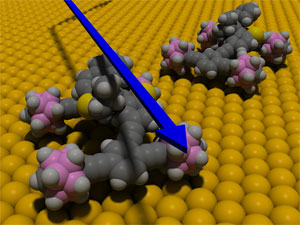Home > Press > Rice Scientists Attach Motor to Single-molecule Car
Abstract:
Light-powered ‘Nanocar’ Helps Researchers Test Bottom-up Construction
Rice Scientists Attach Motor to Single-molecule Car
Houston, TX | Posted on April 13, 2006
In follow-on work to last year’s groundbreaking invention of the world’s first single-molecule car, chemists at Rice University have produced the first motorized version of their tiny nanocar.
The research is published in the April 13 issue of the journal Organic Letters.
“We want to construct things from the bottom up, one molecule at a time, in much the same way that biological cells use enzymes to assemble proteins and other supermolecules,” said lead researcher James M. Tour, the Chao Professor of Chemistry, professor of mechanical engineering and materials science and professor of computer science. “Everything that’s produced through biology – from the tallest redwood to largest whale – is built one molecule at a time. Nanocars and other synthetic transporters may prove to be a suitable alternative for bottom-up systems where biological methods aren’t practical.”
The motorized model of the nanocar is powered by light. Its rotating motor, a molecular framework that was developed by Ben L. Feringa at the University of Groningen in the Netherlands, was modified by Tour’s group so that it would attach in-line with the nanocar’s chassis. When light strikes the motor, it rotates in one direction, pushing the car along like a paddlewheel.
The first nanocar research paper, published the journal Nano Letters last October, was the most-accessed article from all American Chemical Society journals in 2005. That paper was co-authored by Kevin Kelly, assistant professor of electrical and computer engineering.
The nanocar consists of a rigid chassis and four alkyne axles that spin freely and swivel independently of one another. The four buckyball wheels that were used in the original version of the nanocar drained energy from the motor and were replaced with spherical molecules of carbon, hydrogen and boron called p-carborane.
Initial tests carried out in a bath of toluene solvent found that the motor rotates as designed when it’s struck by light. Follow-up tests are underway to determine whether the motorized car can be driven across a flat surface,
The nanocars, which measure just 3-by-4 nanometers, are about the same width as a strand of DNA, but much shorter than DNA. About 20,000 of these nanocars could be parked, side-by-side, across the diameter of human hair. They are the first nanoscale vehicles with an internal motor.
Other members of the research team include postdoctoral associate Jean-François Morin and doctoral student Yasuhiro Shirai.
The research was funded by the National Science Foundation, the Welch Foundation, Honda, the Natural Sciences and Engineering Research Council of Canada and Le Fonds Québécois de la Recherche sur la Nature et les Technologies.
About Rice University:
Rice University is consistently ranked one of America's best teaching and research universities. It is distinguished by its: size: 2,850 undergraduates and 1,950 graduate students; selectivity: 10 applicants for each place in the freshman class; resources: an undergraduate student-to-faculty ratio of 6-to-1, and the fifth largest endowment per student among American universities; residential college system, which builds communities that are both close-knit and diverse; and collaborative culture, which crosses disciplines, integrates teaching and research, and intermingles undergraduate and graduate work. Rice's wooded campus is located in the nation's fourth largest city and on America's South Coast.
For more information, please click here
Contact:Jade Boyd
(713) 348-6778
jadeboyd@rice.edu
Copyright © Rice University
If you have a comment, please Contact us.
Issuers of news releases, not 7th Wave, Inc. or Nanotechnology Now, are solely responsible for the accuracy of the content.
| Related News Press |
Molecular Machines
![]() First electric nanomotor made from DNA material: Synthetic rotary motors at the nanoscale perform mechanical work July 22nd, 2022
First electric nanomotor made from DNA material: Synthetic rotary motors at the nanoscale perform mechanical work July 22nd, 2022
![]() Nanotech scientists create world's smallest origami bird March 17th, 2021
Nanotech scientists create world's smallest origami bird March 17th, 2021
![]() Giant nanomachine aids the immune system: Theoretical chemistry August 28th, 2020
Giant nanomachine aids the immune system: Theoretical chemistry August 28th, 2020
Self Assembly
![]() Liquid crystal templated chiral nanomaterials October 14th, 2022
Liquid crystal templated chiral nanomaterials October 14th, 2022
![]() Nanoclusters self-organize into centimeter-scale hierarchical assemblies April 22nd, 2022
Nanoclusters self-organize into centimeter-scale hierarchical assemblies April 22nd, 2022
![]() Atom by atom: building precise smaller nanoparticles with templates March 4th, 2022
Atom by atom: building precise smaller nanoparticles with templates March 4th, 2022
![]() Nanostructures get complex with electron equivalents: Nanoparticles of two different sizes break away from symmetrical designs January 14th, 2022
Nanostructures get complex with electron equivalents: Nanoparticles of two different sizes break away from symmetrical designs January 14th, 2022
Announcements
![]() NRL charters Navy’s quantum inertial navigation path to reduce drift April 5th, 2024
NRL charters Navy’s quantum inertial navigation path to reduce drift April 5th, 2024
![]() Discovery points path to flash-like memory for storing qubits: Rice find could hasten development of nonvolatile quantum memory April 5th, 2024
Discovery points path to flash-like memory for storing qubits: Rice find could hasten development of nonvolatile quantum memory April 5th, 2024
|
|
||
|
|
||
| The latest news from around the world, FREE | ||
|
|
||
|
|
||
| Premium Products | ||
|
|
||
|
Only the news you want to read!
Learn More |
||
|
|
||
|
Full-service, expert consulting
Learn More |
||
|
|
||









